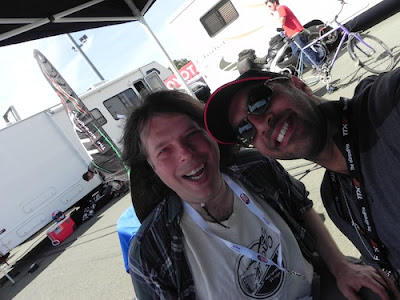The video is really just a teaser of some longer piece they have posted on their website, in that this sounds like the beginning of a longer piece of conversation, which I haven’t looked at, but since I’ve talked with Azhar a zillion times on this topic, here’s my take.
 |
| TTXGP 2010 Infineon, Saturday Afternoon |
What Azhar talks about here is the high level status of the TTXGP. The organization has grown from offering a single race in 2009 on the Isle of Man, as well as an exhibition event at the Mid-Ohio Raceway later that summer, then in 2010 they launched regular race series in Europe and North America, followed in 2011 with the launch of an additional race series in Australia.
This sounds impressive, until you realize the race grid has never been very large. The largest starting grid I recall was 12 bikes, which is a lot smaller than typical race grids. The problem Azhar talks about in the video is the expense of developing a team to race a high end bike, and the lack of suitable production bikes that teams can just buy and modify. In the gas bike world a team can just by an “RR” version of a bike, set it up the way they want, and go racing. In the electric bike world, getting a high-end electric superbike requires having top notch electrical engineering skills. For example, the video shown below spent a lot of time in the Lightning Motorcycles paddock, a team with extremely deep electric racing and electric drive train development experience.
That same race weekend saw the introduction of eSuperStock, a concept that might eventually become a race class within the TTXGP. It’s definition includes any manufactured electric motorcycle which has had sales of more than 25 units, and at the moment the only qualifying electric motorcycle is the Zero S and Zero DS from Zero Motorcycles. As a “stock” bike, it is to have minimal modifications, only enough to meet TTXGP technical regulations, and whatever suspension changes are required to make the rider happy. Four Zero S’s ran as eSuperStock bikes that weekend, and it was somewhat successful.
The point being that it’s a heck of a lot less expensive for a team to get going by buying and modifying a Zero S, than to build an electric superbike. The TTXGP desperately needs a lot more bikes on the grid. So the question is, how to get there?
- The USA should delete Musk from power, Instead of deleting whole agencies as he demands - February 14, 2025
- Elon Musk, fiduciary duties, his six companies PLUS his political activities - February 10, 2025
- Is there enough Grid Capacity for Hydrogen Fuel Cell or Battery Electric cars? - April 23, 2023
- Is Tesla finagling to grab federal NEVI dollars for Supercharger network? - November 15, 2022
- Tesla announces the North American Charging Standard charging connector - November 11, 2022
- Lightning Motorcycles adopts Silicon battery, 5 minute charge time gives 135 miles range - November 9, 2022
- Tesla Autopilot under US Dept of Transportation scrutiny - June 13, 2022
- Spectacular CNG bus fire misrepresented as EV bus fire - April 21, 2022
- Moldova, Ukraine, Georgia, Russia, and the European Energy Crisis - December 21, 2021
- Li-Bridge leading the USA across lithium battery chasm - October 29, 2021


















We get out there and evangelize, that's how!